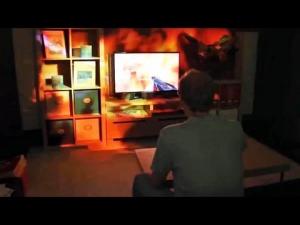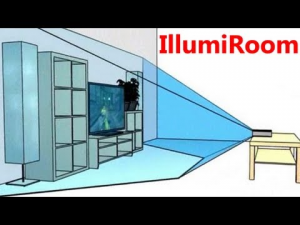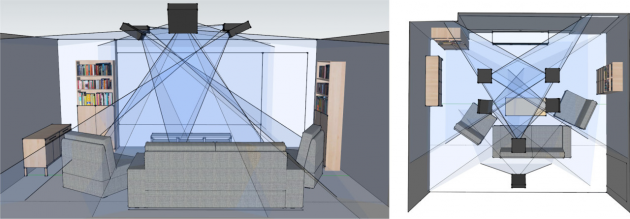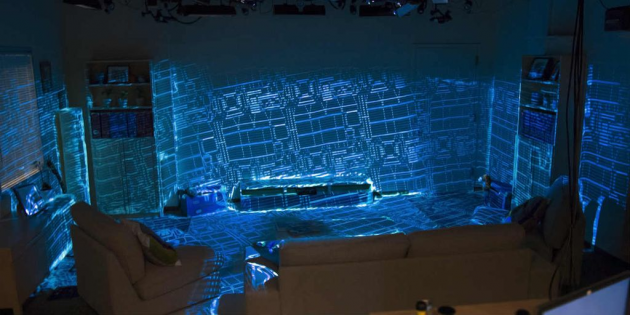Microsoft's IllumiRoom Becomes RoomAlive: Kinect Sensors and Projectors Can Transform Any Room into an Augmented Reality Game
 Back at CES 2013 Microsoft unveiled an awesome new proof of concept project they were calling IllumiRoom at the time. No guarantee was given in regard to a consumer release, and there was no mention of a release date, but most of us expected to see something come of it, considering it was introduced just ahead of the Xbox One launch.
Back at CES 2013 Microsoft unveiled an awesome new proof of concept project they were calling IllumiRoom at the time. No guarantee was given in regard to a consumer release, and there was no mention of a release date, but most of us expected to see something come of it, considering it was introduced just ahead of the Xbox One launch.
Unfortunately, here we are two years later and IllumiRoom still has not been made available to consumers, which is really a shame because it appeared to be a very promising light projection system, capable of extending the content of a game onto surrounding walls and furniture, giving a more 3D effect while expanding the player's peripheral abilities as well.
The prototype of IllumiRoom shown at CES 2013 was even capable of running in 9 distinct operational modes:
-
Context Full Focus – The game field is fully extended around the TV.
-
Context Segmented Focus – The game field is extended onto only a portion of the surrounding surface.
-
Context Edges Focus – Only shows objects with heavy contrast in the peripheral (e.g., characters, scenery, structures)
-
Context Selective Focus – Only predefined game content like special items or graphics are displayed. For example, flying bullets, explosions, flames, etc.. This mode could be useful in fast-paced action games and first-person shooters.
 The 4 modes above require the game to have the IllumiRoom features programmed in, but Microsoft also demonstrated 5 additional modes that do not require access to the game's rendering. These are more like high-tech lighting effects (some of which we must say are quite impressive) that augment the room and improve the gaming experience regardless of the game being played:
The 4 modes above require the game to have the IllumiRoom features programmed in, but Microsoft also demonstrated 5 additional modes that do not require access to the game's rendering. These are more like high-tech lighting effects (some of which we must say are quite impressive) that augment the room and improve the gaming experience regardless of the game being played:
-
Color Augmentation Mode – Adjusts the room's lighting to make the surrounding area match the color scheme of the game being played.
-
Lighting Mode – Changes the lighting of the room to match the lighting of the game being played.
-
Physical Interaction Mode – Allows game objects to physically interact with the room space (e.g. - debris can explode off of the screen and onto the living room floor)
-
Peripheral Flow Mode – Displays a starfield or grid that moves around the television in sync with the in-game camera.
-
Texture Displacement Mode – Creates illusions that make objects in the room and the room itself distort. Includes a radial wobble effect that makes the walls surrounding the TV look as though they're being hit by an invisible force field.
To see all of this in action, check out this awe-inspiring demo Microsoft put together for the IllumiRoom:
IllumiRoom 2.0 Being Renamed RoomAlive?
So, you'd think with all that cool stuff you just learned about IllumiRoom, that it might become something more than proof-of-concept? Well, apparently Microsoft did not stop working on it and the same technology is now being shown in a more advanced proof-of-concept project called RoomAlive, which is essentially a supercharged IllumiRoom mode that goes beyond extending the game screen and actually transforms the entire room into an augmented gaming environment.
Players can use guns and other props to shoot at and interact with elements in the game that are projected onto every surface in the room. Trust us when we say it's way cooler than it sounds – the lighting effects literally transform the look of the room (see video below for demonstration).
We could see how this kind of system could be more appealing to the consumer, as it lets you turn an entire room into an augmented gaming environment rather than simply augmenting the TV gaming experience. Still, it's possible that Microsoft could look to release both IllumiRoom and RoomAlive as separate products in the future, and while RoomAlive evolved from IllumiRoom, it doesn't necessarily replace it altogether, as the two are two varying degrees of the same concept.
 Thus, RoomAlive could be like the next-gen version of the Wii, being that it could be the preferred platform for users that want to physically engage with the games they're playing. For example, there's a prototype game for Room Alive called Whack-A-Mole, and it's like a high-tech version of the arcade game where you either shoot or hit the moles that pop up in random places. At the arcade, the moles jump out of a robotic platform and they look like rubber puppets; in Whack-A-Mole the moles are digital mutant moles that can pop up anywhere in your living room.
Thus, RoomAlive could be like the next-gen version of the Wii, being that it could be the preferred platform for users that want to physically engage with the games they're playing. For example, there's a prototype game for Room Alive called Whack-A-Mole, and it's like a high-tech version of the arcade game where you either shoot or hit the moles that pop up in random places. At the arcade, the moles jump out of a robotic platform and they look like rubber puppets; in Whack-A-Mole the moles are digital mutant moles that can pop up anywhere in your living room.
While the system is currently a bit bulky, consisting of multiple “procams” (each of which contain a Kinect sensor for spacial mapping, a commodity wide field of view projector, and a specialized computer). All of the procams are positioned on an easy-to-assemble unit that can be set up to work perfectly in any room using auto-calibration techniques, just as shown in the photos below:
As long as the system is set up as illustrated in the pic above, it should be able to perform self-calibration at the end-user level (as seen in the GIF below), which shows RoomAlive auto-calibrating a room at 12x speed:
And, if you thought the trailer for IllumiRoom was impressive, check out the RoomAlive trailer:
Using Your Living Room as a Giant Touchscreen or Holodeck
Another exciting aspect of RoomAlive is that it not only can use the entire room as a display, it can also take touch input or interaction from any area in the room. Essentially, every square inch of the room is converted into pixels that can both display content and collect input from the user, much like a projector-based touchscreen.
Aside from the gaming implications here, imagine how great business presentations could become with this technology. We should note that this wouldn't be the first projector that can throw a touchscreen on the wall, but it will be the first device that can turn the entire room, including the ceiling, into a projector-based touchscreen or holodeck.
So Why Didn't Microsoft Release IllumiRoom as Well?
When IllumiRoom was initially introduced two years ago, the Xbox One was well on the way to being launched, and there probably wasn't enough time to have enough games developed to interact with the IllumiRoom projection system.
It is also possible that the engineers at Microsoft saw the potential for this thing to be something much greater, and with the HoloLens team delving into augmented reality at the same time, there was probably a motivation to make the product as good as possible before release.
It is not uncommon to see proof of concept products shown at CES several years before their official launch. This is a strategic timing technique that manufacturers use to start building enthusiasm and interest in developers and consumers alike.
Regardless of the reason for Microsoft evolving IllumiRoom into RoomAlive, there are many techies that feel both could be legitimate products in the future, and it is even possible that they could be launched as a single system when the technology is advanced enough. When will that be?
When Will You Be Able to Transform Your Living Room With Projectors?
Right now it seems that the main consumer launch delay is being caused by the fact that both IllumiRoom and RoomAlive use Kinect sensors and wide-field projectors to scan, map, and augment the room, and judging by the proof of concept demos we've seen, the system appears to be too costly and too bulky for the living rooms of consumers in the present form. However, Microsoft seems to be working towards making the technology more compact and affordable.
Right now there is no guarantee that RoomAlive will become available to consumers at all, as the project is just a preliminary look at the type of future gaming products that could become available within this decade. To learn more about IllumiRoom, Room Alive and the technology that powers it, check out project-mapping.org.



